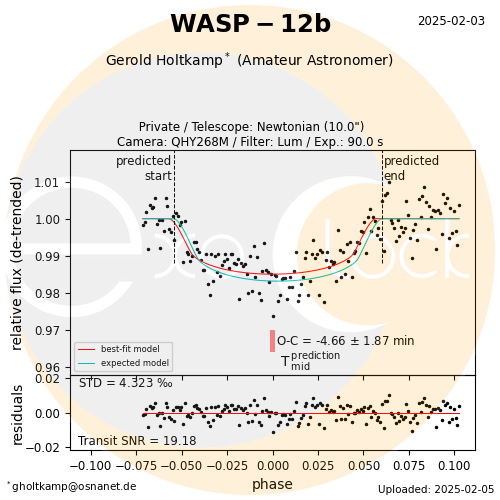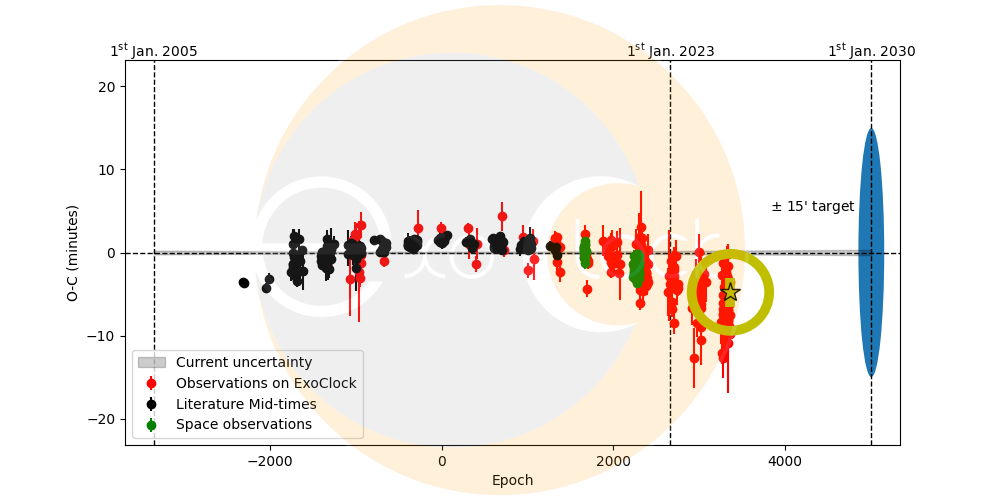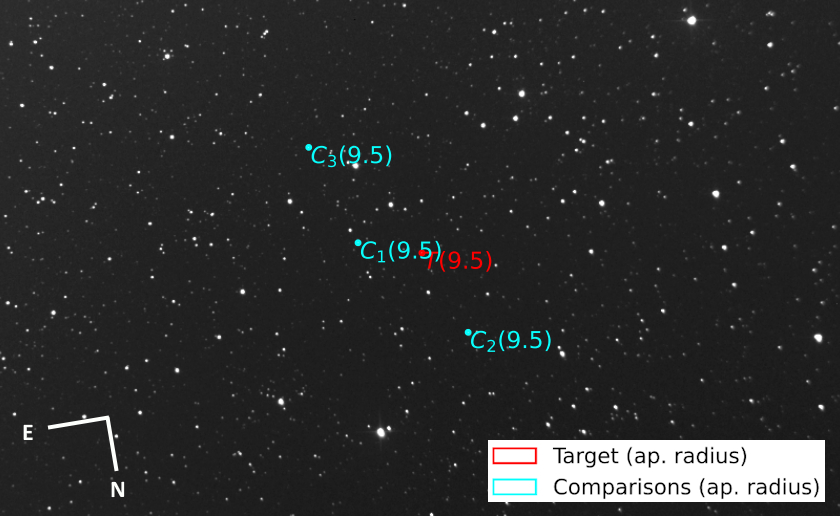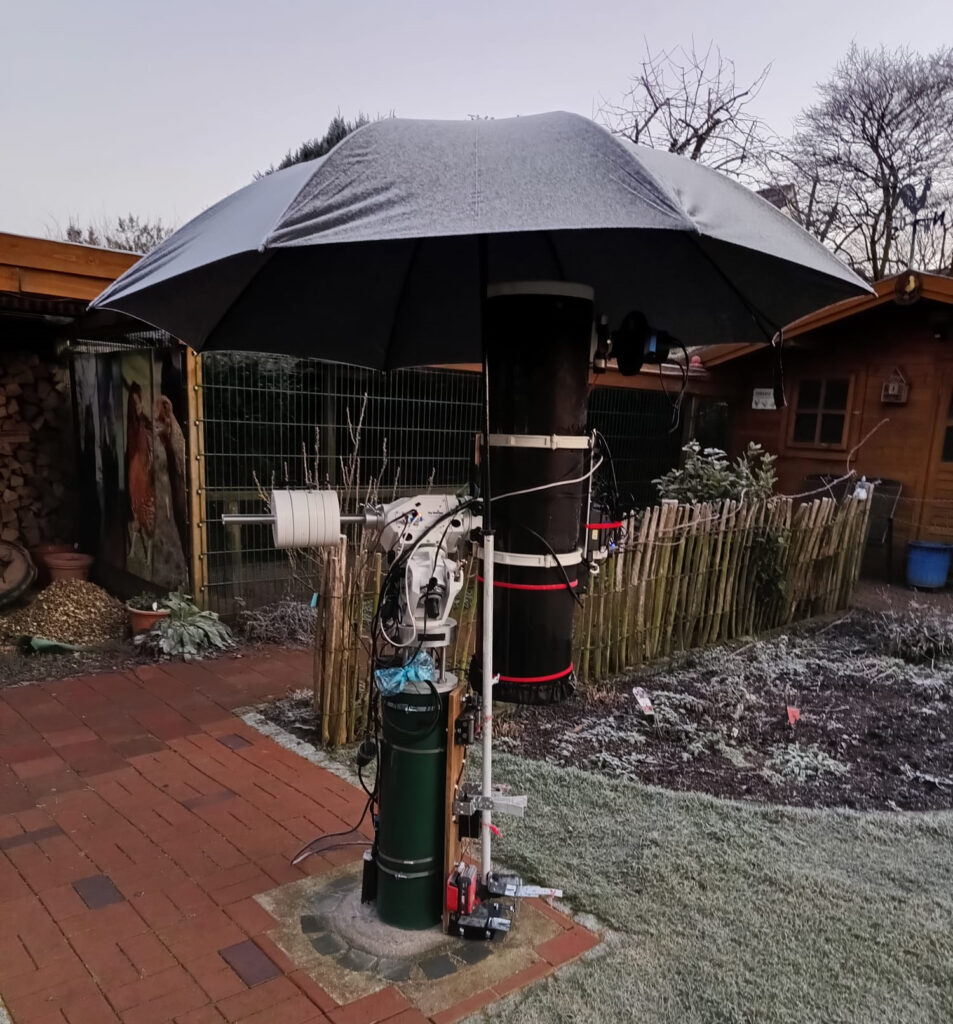– Measurement of the transit light curve of the exoplanet Wasp-12b on February 3, 2025 –
Report by Dr. Gerold Holtkamp, February 14, 2025
The measurement of the transit light curve of the exoplanet Wasp-12b is described. This exoplanet is special in many ways. The large number of existing transit light curves, including our own measurements, enables spectacular predictions about the lifespan of the exoplanet.
The exoplanet Wasp-12b was discovered in 2009 as part of the Wide-Angle Search for Planets (WASP) project. With a radius 1.8 times that of Jupiter, it is not only one of the largest exoplanets discovered to date, but also one of the hottest, with a surface temperature of 2,520 K. The orbital period around its parent star Wasp-12 of 1.09 days is one of the shortest known to date. The planet's close proximity to its sun of 3.47 million km causes strong deformation via tidal forces, so that it looks more egg-shaped. In addition to the intense radiation from the parent star, these forces play a large part in the intense heating of the planet [1]. Measurements of the exoplanet's surface brightness during occultations by the parent star (as seen from Earth) with the Hubble Telescope have shown that its reflectivity is very low. It should be as black as fresh asphalt. However, with its high temperature it will also emit light itself. [2]
The parent star Wasp-12, spectral type F, forms a triple system with the stellar companions Wasp-12B and Wasp-12C. Wasp-12B and Wasp-12C revolve around each other and their center of gravity in turn revolves around the shared center of gravity with Wasp-12. The companions are dwarf stars of spectral type M, which are 21 AU (Earth-Sun distance) apart. This pair is in turn separated by 450 AU from Wasp-12. [3]
A remarkable property of the exoplanet Wasp-12b, which is most interesting to amateur astronomers because it can be measured by them, is its changing orbital period around its parent star. Since it was discovered in 2009, a large number of transit measurements are now available from which changes in orbital times can be determined. Amateur measurements also come into play here. They make a significant contribution to the observation of the system. A single measurement can only determine the beginning and end of the exoplanet's passage in front of its parent star (and the intensity of the obscuration of the parent star) on a specific date. The sum of the time measurements then shows the change. Currently a rate of 30 ms/year (dP/dt = −29.81 ± 0.94 ms yr−1) is given. From this it can be deduced that its orbit is not stable. It will fall onto its star in about 3 million years or will be torn apart by the strong gravitational forces before then. Other causes for the transit time change such apse rotation could be ruled out. [4]
Wasp-12b is therefore an extremely interesting object to observe. Due to its 3.47 million km proximity to the parent star, it was also selected for the Exoclock project. The project serves to prepare for a planned ESA Ariel mission to study exoplanet atmospheres. Exoclock promotes and collects transit measurements from amateur astronomers. I also took up the suggestion for measurement from the Exoclock database. [5]
The Measurement
The measurement setup is the same as in earlier measurements [6]. The Moon initially was approximately 26° high in the constellation Pisces, was 33% illuminated and 71° from the position of Wasp-12b. There was no wind and the temperature was around 0° C. The humidity was high.
The measurement was taken on February 3rd, 2025 from 9:05 p.m. CET to February 4th, 2025 at 12:37 a.m. CET. The exposure time was 90s. An Antlia brand luminance filter was used. 181 individual recordings were created. The evaluation was carried out using the hops software from the Exoclock project (see also [6]). The data can also be viewed in the Exoclock database [7].
The Measurement Results


It confirms the change in the orbital period of Wasp-12b.


Appendix: System data [8]
Wasp-12 (2MASS J063032.79+294020.4)
Spectral Type: F
Apparent brightness: 11.6 mag (V)
Distance: 1,393 light years
Surface temperature: 6,300 K
Mass: 1.17 times the mass of the Sun
Radius: 1.75 times the radius of the Sun
Constellation: Auriga
Wasp-12B (stellarer Begleiter) ([3] und nur für Wasp-12B [9]) https://exoplanetarchive.ipac.caltech.edu/overview/WASP-12#nearby_WASP-12-C_collapsible)
Spectral type: M3
Apparent brightness: 19.9 mag (V)
Mass: 0.38 times the mass of the Sun
Wasp-12C (stellar companion) ([3])
Spectral type: M3
Mass: 0.37 times the mass of the Sun
Wasp-12b (Exoplanet) [1]
Discovery: 2009
Distance to the parent star: 3.47 million km (large semi-axis)
Orbital period: 1.09 days
Surface temperature: 2,520 K
Mass: 1.46 times the mass of Jupiter
Radius: 135,000 km (radius of Jupiter 69,911 km) (Rp = 1.825 Rjup)
__________________________________________________
[1] L. Hebb et al., The Astrophysical Journal, 693:1920–1928, 2009 March 10
[2] Taylor J Bell et al., The Astrophysical Journal Letters, 847:L2 (6pp), 2017 September 20
[3] Eric B. Bechter et al, The Astrophysical Journal, 788:2 (6pp), 2014 June 10
[4] Samuel W. Yee et al, The Astrophysical Journal Letters, 888:L5 (11pp), 2020 January 1
[5] https://www.exoclock.space/
[6] https://kosmos-os.de/messung-der-transitlichtkurve-des-exoplaneten-toi-2570-b
[7] https://www.exoclock.space/database/observations/WASP-12b_8397_2025-02-03_Gerold_1561_Lum/
[8] https://exoplanetarchive.ipac.caltech.edu/overview/WASP-12
[9] https://exoplanetarchive.ipac.caltech.edu/overview/WASP-12#nearby_WASP-12-C_collapsible
For an extensive literature collection on the Wasp-12 system see: https://exoplanet.eu/catalog/wasp_12_ab–459/